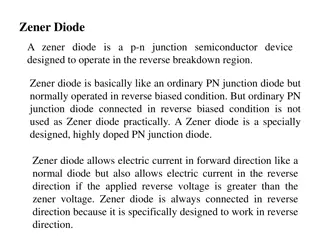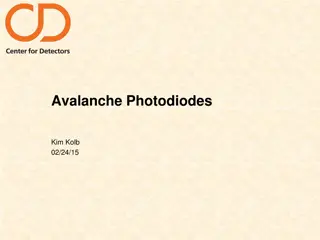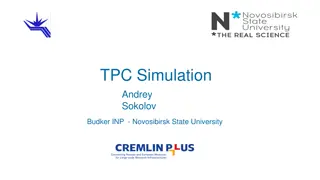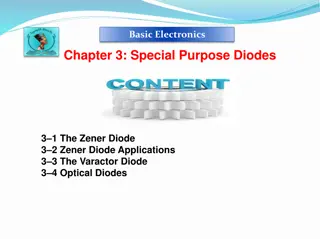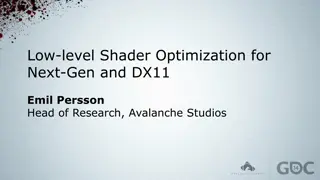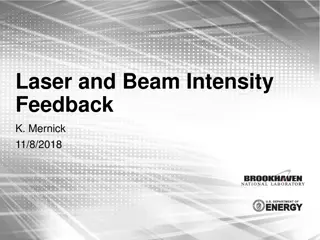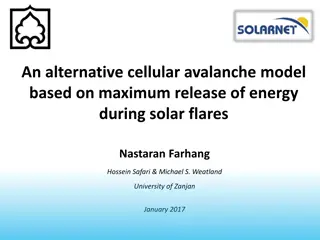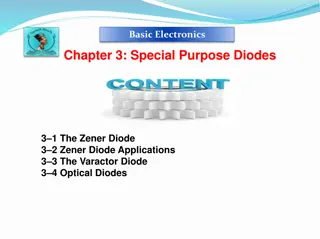Understanding Zener Diodes: Breakdown Mechanisms and Symbol
A Zener diode is a specialized semiconductor device designed to operate in the reverse breakdown region, with two types of breakdown - avalanche and Zener. Avalanche breakdown occurs at high reverse voltages in both normal and Zener diodes, while Zener breakdown is specific to heavily doped P-N junc
9 views • 19 slides
Understanding P-N Junction Diodes and Zener Diodes
A normal p-n junction diode allows electric current only in forward biased condition, offering small resistance. When reverse biased, it blocks current. If the reverse biased voltage is highly increased, it can lead to zener or avalanche breakdown. Zener diodes are specifically designed for working
0 views • 19 slides
Dark Side of the Afterglow: Complications in Dark Matter and Rare Events Searches
Exploring the challenges in detecting dark matter and rare events due to energy accumulation, excitation clustering, and avalanche relaxation events. Discusses issues such as low-energy background, ionization load on detectors, dual-phase detectors, universal scenarios of energy accumulation, and en
0 views • 15 slides
Analysis of Electron Multiplication in Avalanche Gain Process
This report analyzes the phenomenon of electron multiplication in the avalanche gain process, specifically focusing on the gains and transparencies at different stages within the system. The study involves Gem foils and Polya distributions to understand the effective gains and transparency percentag
0 views • 6 slides
Understanding Avalanche Photodiodes: Principles and Applications
Explore the world of Avalanche Photodiodes (APDs) through a comprehensive discussion covering solid-state physics, band theory, PN junctions, I-V characteristics of diodes, breakdown mechanisms, and practical design considerations. Learn about linear mode versus Geiger mode operation, performance me
0 views • 31 slides
Understanding Photodiodes: Operation, Types, and Symbols
A photodiode is a sensitive semiconductor device that converts light into electric current. Operating in reverse bias, it generates charge carriers in the depletion region using external energy sources such as light. Different types include PN junction, PIN, and avalanche photodiodes, each designed
1 views • 36 slides
Overview of SMX Algorithm and AES Encryption Standard
The SMX Algorithm presents a fresh approach to the avalanche effect in the Advanced Encryption Standard (AES). Initially developed to overcome the limitations of the Data Encryption Standard (DES), AES boasts improved security and efficiency, supporting key lengths of 128, 192, and 256 bits. The AES
3 views • 19 slides
Cutting-Edge TPC Simulation Techniques at Budker INP & NSU
Cutting-edge TPC simulation techniques implemented by researchers at Budker INP and NSU include framework implementations, event displays, background simulations, track distortions, and gas medium simulations. Researchers like Andrey Sokolov, Lev Shekhtman, Vijayanand KV, and Timofey Maltsev have co
0 views • 15 slides
Understanding Zener Diodes in Analog Electronics
Zener diodes are heavily doped semiconductor devices designed to operate in reverse bias conditions. They exhibit the Zener effect where breakdown occurs, allowing current flow in the reverse direction. These diodes maintain a constant voltage (Zener voltage) across them, making them useful as volta
3 views • 12 slides
Understanding Special Purpose Diodes in Basic Electronics
Explore the functionalities of zener diodes, varactor diodes, LEDs, quantum dots, and photodiodes in electronic circuits. Discover the characteristics, operations, and applications of these special purpose diodes, including voltage regulation, light emission, and light detection.
0 views • 18 slides
Optical Testing Setup Procedures for Vacuum Windows and Polarizers
Detailed procedures for optical testing setups involving vacuum windows, polarizers, rotation stages, translation stages, photodiodes, scopes, power meters, and more. The process includes preparing the initial state, rotating analyzers, monitoring transmission, and verifying the direction and magnit
0 views • 5 slides
Insights into Low-Level Shader Optimization for Next-Gen Technology
Delve into the world of low-level shader optimization for the next generation and DX11 with Emil Persson, Head of Research at Avalanche Studios. Uncover key lessons from the previous year, explore modern hardware developments, and grasp the intricacies of sampling a cubemap. Witness the evolution of
0 views • 52 slides
Intensity Feedback System for Laser Beam Control
The intensity feedback system aims to maintain stable beam current and investigate DC gun performance. Using motor-controlled half wave plates and electro-optical modulators, the system achieved 2% rms stability. Initial measurements with photodiodes revealed challenges, but signals from the gun tab
0 views • 14 slides
Alternative Cellular Avalanche Model for Solar Flares
Exploring an alternative cellular avalanche model based on the maximum release of energy during solar flares, this research delves into optimizing models to study the quasi-static evolution of coronal magnetic fields. Through a series of image objects and studies, the study presents various cellular
0 views • 16 slides
Understanding Special Purpose Diodes in Electronics
Explore the Zener diode and its characteristics for voltage regulation. Learn about the Varactor diode and its operation. Delve into the features, operation, and applications of LEDs, quantum dots, and photodiodes in electronics.
0 views • 38 slides
